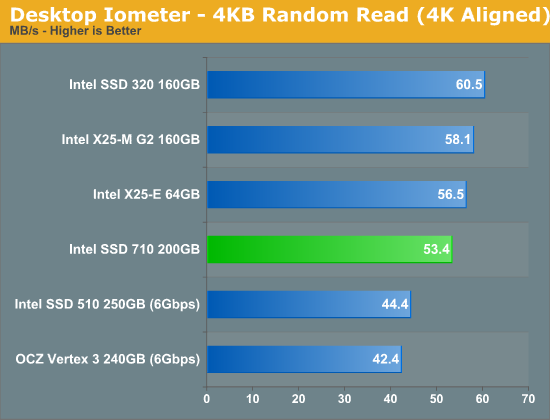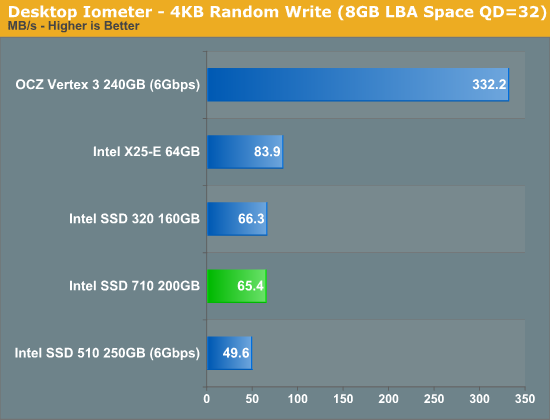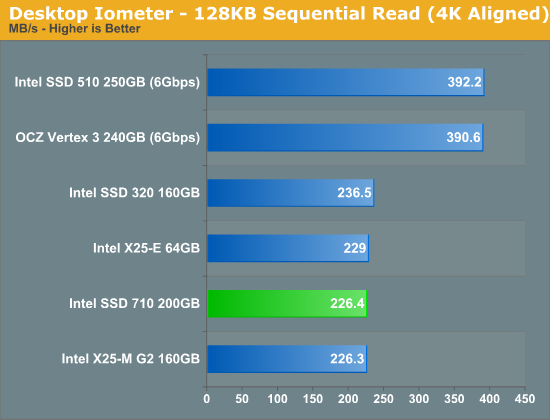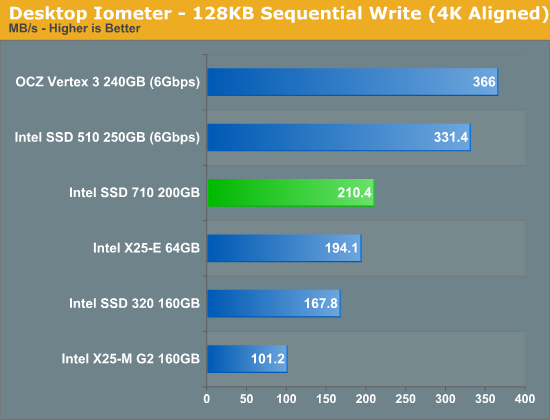The Intel SSD 710 (200GB) Review
by Anand Lal Shimpi on September 30, 2011 8:53 PM EST- Posted in
- Storage
- SSDs
- Intel
- Intel SSD 710
Random Read/Write Speed
The four corners of SSD performance are as follows: random read, random write, sequential read and sequential write speed. Random accesses are generally small in size, while sequential accesses tend to be larger and thus we have the four Iometer tests we use in all of our reviews.
Our first test writes 4KB in a completely random pattern over an 8GB space of the drive to simulate the sort of random access that you'd see on an OS drive (even this is more stressful than a normal desktop user would see). I perform three concurrent IOs and run the test for 3 minutes. The results reported are in average MB/s over the entire time. We use both standard pseudo randomly generated data for each write as well as fully random data to show you both the maximum and minimum performance offered by SandForce based drives in these tests. The average performance of SF drives will likely be somewhere in between the two values for each drive you see in the graphs. For an understanding of why this matters, read our original SandForce article.

Random read performance is actually a bit behind the SSD 320 and old X25-M G2, but still within the same ballpark and comparable to the X25-E. Note that random read performance has always been a strong suite of Intel's, which is very important to many database workloads.

Random write performance is in the same ballpark as the other Intel MLC SSDs, however the X25-E is noticeably faster. SLC NAND is always easier to write to, and we see that advantage clearly here. Although the 710 does ok here, newer controllers from SandForce have raised the bar for highly compressible random write performance by a significant margin.

At high queue depths the X25-E is still significantly faster. Given the random nature of many enterprise server workloads, the 710 could end up slower than the X25-E.
Sequential Read/Write Speed
To measure sequential performance I ran a 1 minute long 128KB sequential test over the entire span of the drive at a queue depth of 1. The results reported are in average MB/s over the entire test length. These results are going to be the best indicator of large file copy performance.

Sequential speed is also quite similar to other Intel drives. Note the slight drop in performance compared to the SSD 320. With the type of workloads the 710 is aimed at, I don't expect large file sequential performance to be a limiting factor. Once again we see that newer 6Gbps controllers from Marvell and SandForce offer much better performance here.

Sequential write performance is up quite a bit over the previous generation drives. The additional spare area is part of the story here, though the 6Gbps controllers still maintain their lead.










68 Comments
View All Comments
igf1 - Saturday, October 1, 2011 - link
My God, how did the vertex 3 get so far ahead of the pac?Broheim - Saturday, October 1, 2011 - link
how could a SATA 6GB/s drive possibly be faster than a bunch 3GB/s drives? oh wait...floam - Saturday, October 1, 2011 - link
How well should this drive do without TRIM? I imagine this is somewhat important to those doing RAIDs. Or in my case, just holding one big giant VHD file.inplainview - Saturday, October 1, 2011 - link
Anand,Start charging for access to your site and see how many of the hardcore keyboard banging, momma's basement dwellers will actually fork over cash to keep things here uber-techie. I can appreciate the work that you're doing even if it not as nuts and bolts as some would like. I've gleaned valuable info that has helped me to make some informed purchases that I am quite happy with. For that I think you.
mmrezaie - Saturday, October 1, 2011 - link
What I really like to see in these SSDs is the impact of encryption. Not just hardware level, but software solutions from both windows, and Linux. it seems that they are getting more and more important these days.Ushio01 - Saturday, October 1, 2011 - link
Anand since you now have an enterprise storage bench will you be reviewing the Micron RealSSD P300 and P400e SSD's especially the P300 as it uses SLC nand with a 6.0 Gb/s controller.tipoo - Saturday, October 1, 2011 - link
What kind of mic that is.geok1ng - Saturday, October 1, 2011 - link
is thesse drive have 40%+ spare area, then cost per GB is actually $3 to $4, Inline with premium market.And there is already a ssd that uses 50% spare area, the cache oriented OCZ Nocti, that i would like to see a review, compared with 20gb 311 series, 40g Corsair F40 and Crucial m4 64GB.
sheh - Saturday, October 1, 2011 - link
200GB != 200,000,000,000,000 bits200GB == 200,000,000,000 bytes
---
Data retention always worried me. Is that 1 year retention for consumer drives only once it's exhausted its writable days or also for brand new?
Do drives refresh themselves or is there a need to do a read-rewrite everything once in a while?
freespace303 - Saturday, October 1, 2011 - link
Where are the Crucial drives on here? I have one and would love to see how they stack up against these new Intel drives.